|
ANIMAL
ITEMS:
Alaska Carvings & Travels
Alaska
Artifacts
Animal Carvings-Other
Australian
Art
Bronze Works
Bug & Crab Specimens
Exotic Leather Accessories
Gator Items
Gem Animals
Narwhal Tusks
Parasite
Wood Carvings
Safari Animal
Mounts
Sawfish bills
Shark Items
Shark Jaws
Tagua Nut Carvings
Teak Carvings
JEWELRY
ITEMS
Amber Items
Brooches
Cameos
Czech
brooches
Dichroic Glass
Jewelry
Earrings
Eyeglass Holders
Fairy Stone Crosses
Hatpins
Key chains
Maori Fish Hook Necklaces
Music
Jewelry
Necklaces
Opals &, Ivory Items
Pendants
Rings
Titanium
Jewelry
Vintage
Jewelry
FOSSIL ITEMS
Cave Bear Fossils
Dinosaur
Fossils
Mammoth
Fossils
Fossils-Others
Poop Fossils
Poop-Moose & Deer
Fossil Shark Teeth
CLOSEOUT
SALES:
Marbles
Closeout
Sales-Other
ROCK ITEMS
Meteorites
Rocks & Mineral-Other
OTHER COOL
STUFF FOR SALE
Alien Gifts
Boxes boxes
Gemstone
skulls
Indian
Artifacts
Medallions & Coins
Swords,
Daggers, Knives
The Weirdest
Zoo
books & Books
HUMAN
INTEREST
About Us
Cool
Customers
Jesse Nusbaum, Artist
Latest
Travels
2013 Travel America
Newsletter
Support Our Troops
Tina Memorial
Zany & Fun
FOLLOW us on TWITTER for
special DISCOUNTS



| |
You are on Dinosaur Fossils page 1
| TABLE OF CONTENTS
DINOSAUR FOSSILS
Page 1 - (You are On page 1, scroll down to view)
Dinosaur eggs (Hadrosaur, Oviraptor), eggshell, embryo
replica,
Fossil set (Dino bone, coprolite, eggshell),
Dinosaur medallions,
T-Rex magnets,
Dinosaur skeleton cast replica (Dromaeosaurus
albertensis);
Edmontosaurus tendons, tooth, bone in Riker box,
T-Rex Gem carving in serpentine,
Photos of Sue the Tyrannosaurus, T-Rex head mount,
keychain holder (photos only)
Page 2 -
Dinosaur teeth (Carcharodontosaurus and Spinosaurus), claw (Pteranodon); Dinosaur footprint
Page 3 -
Dinosaur bone - necklaces and Lapidary/display slices
Page 4 -
Dinosaur bone slices and ends (continued from page 3), Dinosaur leg bone specimens/chunks,
Moab Dinosaur bone polished ends and chunks (DF374 to DF481 series)
Page 5 -
Article "The Poop on Scoop" about Dinosaur coprolite, Dinosaur Coprolite (Poop) - Lapidary/display slices
Page 6 -
Dinosaur Coprolite (Poop) - 1 end polished
Page 7 -
Dinosaur Coprolite (Poop) - 1 end polished (continued)
Page 8 -
Dinosaur Coprolite (Poop) - Natural specimens
Page 9
- Dinosaur Picture
Gallery |
| GENUINE
DINOSAUR
EGGS |





Single Hadrosaur egg on matrix,
measures 6.5" long, 5" wide, 5" high, and has a LARGE
circumference of 19". It weighs 7.75 pounds. This size
puts it in the top 4% size for this species. Therefore, we know it
was laid by a fully grown, mature female who had already reproduced during
previous breeding seasons, possibly an alpha female. This specimen
is in better-than-expected condition, ranking 8.0 Choice on a scale of 1
to 10. $425 SOLD
|
|




Double Hadrosaur egg (duo)
specimen on matrix, measures 9" long, 6.5" wide, 5.25"
tall, with a circumference of 27". It weighs 15 pounds.
Quality ranks 7.6 on a scale of 1 to 10 due to symmetry, shape, posture,
matrix, size, coloring, shell texture, and degree of shell
coverage. SOLD
|
|




#DF-1 RARE SIX EGG NEST, measures
14" long, 12.5" wide, 7.75" tall, with a circumference of
3.7 feet (44.75") around. It weighs 63 pounds. A special
acquisition for us, one that we are offering for sale to that special
collector that will appreciate it as we do.
$3800 SOLD
|

Genuine Hadrosaur Dinosaur
Fossil egg specimens above are Hadrosaurid, Late Cretaceous (84-71 million years old),
collected in the Xixia Basin, Henan Province of China. Fossil eggs are found
in China, the Badlands of the Western U.S., and in Patagonia. The egg becomes covered with soil relatively
quickly after being laid, which protected it from scavengers, climate and
oxygen. Ground water flowing through the sediment passed through the egg
and allowed minerals to precipitate into the egg, which eventually turned it to
stone, though keeping its original shape (like petrified wood). It is
possible, but unlikely, that the bones of the embryo may be found inside, as it
may not have developed enough before its death. A special addition to any fossil collection!
|
|



One of our customers, Tom (on far left of second picture) brought this possible
dinosaur egg in to be examined by the Smithsonian fossil experts (Bob Purdy) at
the 2002 Ocean Lakes Fossil Fair in Myrtle Beach SC -
he suggested Tom take it to New York to the museum there for final verification,
but it passed their initial test! Cool!
|
| OVIRAPTOR
DINOSAUR
TWO EGG NEST |
|
(GENUINE, NOT A
REPLICA)
OVIRAPTOR 70-88
Million Years Old
Weighs 11 pounds,
measures 7-1/2" long x 7" wide; eggs measure 7-1/4" long
each, x 2-3/4" wide
Oviraptor is a
genus of small Mongolian theropod dinosaur, first discovered by the
paleontologist Roy Chapman Andrews, and first described by Henry Fairfield
Osborn, in 1924. Its name is Latin for 'egg thief', referring to the fact
that the first fossil specimen was discovered atop a pile of what were
thought to be Protoceratops eggs, and the specific name philoceratops
means "lover of ceratopsians", also given as a result of this
find. In his 1924 paper, Osborn explained that the name was given due to
the close proximity of the skull of Oviraptor to the nest (it was
separated from the eggs by only four inches of sand). However, Osborn also
suggested that the name Oviraptor "may entirely mislead us as
to its feeding habits and belie its character". In the
1990s, the discovery of nesting oviraptorids like Citipati proved
that Osborn was correct in his caution regarding the name. These finds
showed that the eggs in question probably belonged to Oviraptor
itself, and that the specimen was actually brooding its eggs.
Oviraptor lived in
the late Cretaceous period, during the late Campanian stage about 75
million years ago; only one definitive specimen is known (with associated
eggs), from the Djadokhta Formation of Mongolia, though a possible second
specimen (also with eggs) comes from the northeast region of Inner
Mongolia, China, in an area called Bayan Mandahu.
When living, Oviraptor
was one of the most bird-like of the non-avian dinosaurs. Its rib cage, in
particular, displayed several features that are typical of birds,
including a set of processes on each rib that would have kept the rib cage
rigid. A relative of Oviraptor called Nomingia was found
with a pygostyle, which is a set of fused vertebrae that would later help
support the tail feathers of birds. Skin impressions from more primitive
oviraptorosaurs, like Caudipteryx and Protarchaeopteryx,
clearly show an extensive covering of feathers on the body, feathered
wings and feathered tail fans. A tail fan is also indicated by the
presence of a pygostyle in Nomingia, suggesting that this feature
was widespread among oviraptorosaurs. Additionally, the nesting position
of the brooding Citipati specimens implies the use of feathered
wings to cover the eggs. Given the close anatomical similarity
between these species and Oviraptor, it is highly likely that Oviraptor
had feathers as well.
Oviraptor is
traditionally depicted with a distinctive crest, similar to that of the
cassowary. However, re-examination of several oviraptorids show that this
well-known, tall-crested species may actually belong to the genus Citipati,
a relative of Oviraptor. It is likely that Oviraptor
did have a crest, but its exact size and shape are unknown due to crushing
in the skull of the only recognized specimen.
Oviraptor
was originally allied with the ornithomimids by Osborn due to its
toothless beak. Osborn also found similarities with Chirostenotes,
which is still considered a close relative of Oviraptor. In
1976, Barsbold erected a new family to contain Oviraptor and its
close kin, making Oviraptor the type genus of the Oviraptoridae.


#DF-2 $3200
SOLD |
| Genuine
DINOSAUR
EGG SHELL FRAGMENTS

These dinosaur eggshell fragments are from a
SALTASAURUS dinosaur
egg, Late Cretaceous period . Rio Colorado Formation, Auca Mahuevo,
Patagonia, Argentina.
The word "Saltasaurus" is
occasionally spelled "Saltosaurus", even by palaeontologists.
Saltasaurus (which means "lizard from Salta") is a genus of
sauropod dinosaur of the Late Cretaceous Period. Relatively small among
sauropods, though still massive by human standards, it was characterized
by a diplodocid-like head (with blunt teeth, only in the back of the
mouth) and was the first discovered with small bony plates embedded in its
skin. The bony plates (a form of armor called osteoderms) have since
been found in other titanosaurids, and a crest of scutes has also been
discovered, running down the back of diplodocids. When the plates of
a Saltosaur were originally found, independently of skeletal remains, they
were assumed to be from an Anklysaurian, whose plates they
resemble.
A large Saltasaurus/Titanosaur nesting ground
was discovered in 1997, by Luis Chiappe and his team, near Auca Mahuevo, in
Patagonia, Argentina. The small eggs, about 11 to 12 centimeters (4
to 5 inches) in diameter, contained fossilized embryos,
complete with skin impressions (although there was no indication of
feathers or dermal spines). These eggs may have belonged to Saltasaurus.
Apparently several hundred females dug holes,
laid their eggs and then buried them under dirt and vegetation. This gives
evidence of herd behavior, which, along with their armor, may have been a
defense against large predators.
|
| SET
OF TWO OR THREE pieces of fossil dinosaur egg fragments
$10 each set |

#DF-5-X |
   
Annette, our customer from here in Myrtle Beach, brought in what
she believed to be a dinosaur egg, found in Arkansas near Lockesburg AR where a
few remains of the Arkansaurus fridayi have been found. Our local
chiropractor, Dr. Causey, x-rayed it for us..though there's no embryo, there is
a definite thickness around the edge that appears to be shell. We'll be
contacting the New York Museum to speak with a dinosaur egg expert there to get
authentication, if this is indeed what it is. An incredible find, if
so! Thanks for sharing, Annette!
| DINOSAUR
EMBRYO REPRODUCTION |
|
  
Dinosaur embryo in jar, 7"
lab specimen jar, 3" across; other two photos are what he looks like before
being put in the tea water, Latex, folks...fooled ya! Molded from the real
thing.
OUT OF PRODUCTION,
DISPLAY ONLY
|
| DROMAEOSAURUS
ALBERTENSIS cast |
| 11/6/10 Here's our new
"baby", a Dromaeosaurus albertensis dinosaur skeleton museum cast, measuring 6'9" long x 34" tall.
A superb specimen any museum or private collector would be pleased to
display.
We are proud parents to a
Dromaeosaurus albertensis (Therapod) dinosaur
cast (also called a "Drom") we acquired from a Minnesota
collector. The "baby" is 6'9" long x 34"
tall. Here is Glenn in our living room showing it off after it
arrived this morning and we reassembled it. The base is purposely
unfinished, the new buyer can spray-foam, papier-mache or fabric-cover
it as needed for exhibiting in its final resting place. Drom
will be
placed under Mrs. Cave Bear so we can still walk through to the kitchen,
truly a Monster Strait to walk each day.
Dromaeosaurus
was a genus of Theropod dinosaur which lived during the Late Cretaceous
period (middle late Campanian), between 76.5 and 74.8 million years ago,
in the Western United States and Alberta, Canada. The name means
"running lizard". It was a small carnivore, about 2 m (6.5 ft.)
in length and 33 pounds in weight. Its mouth was full of sharp
teeth, and it had a sharp "sickle claw" on each foot.

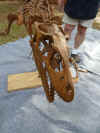





Close-up of feet - front, then back






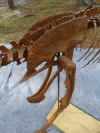



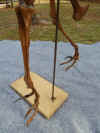


$12,000 SOLD
|
| Dinosaur
FOSSIL SETS
(Dinosaur bone, coprolite & egg
shell)
|
 |
#DF-11
Great set! Specimens of
dinosaur bone, coprolite and eggshell fragment included with 4x magnifier and
prehistoric timeline! Generous-sized specimens are 1 or more inches
across.
|
$18.00 (3
available) |
|
Dinosaur Coin Medallions
1-1/2" across, heavy, detailed
minted bronze from the Hoffman Mint (photos show front & back)
$15.00 each |
| |

#DF-12-B. Triceratops (2 available) |

#DF-12-C. Stegosaurus (1 available)
|
|

#DF12-E. Apatosaurus SOLD
OUT
|

#DF12-F. T-Rex (18 avaiable) |

#DF12-G. Albertosaurus (1
available)
|

#DF12-H. Pteranodon (4 available) |

#DF12-J. Iguanodon (4
available)
|

#DF12-L. Megalosaurus (4 available) |

#DF12-M. Polacanthus (4
available)
|
|




If you cant get
enough coins, follow this link to see the different types we have available. |
T-Rex
thermometer/magnet
|
 |
#DF-40
T-Rex thermometer / magnet,
1" x 5"
|
$9.00
(7
available) |
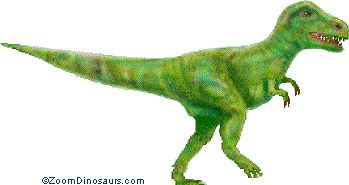
| EDMONTOSAURUS
ossified tendons, tooth and bone fragments in Riker mount display box
16 x 12 x 3/4" deep, glass
topped display; four matrix measure clockwise:
1-3/8" x 1"/
1-3/4" x 1-1/4"/ 2-1/2 x
1-1/2"/ 1-1/2 x 1-1/8" plus one 3/8" fragment
loose
The largest of the duck-billed
hadrosaurs (among the most common herbivores of the late Cretaceous
period), bigger than T.rex |


#DF-198. $150.00 |
Why dinosaurs went extinct
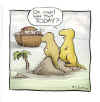
|

This is a great T-Rex made out of old machine parts we found
in downtown Waynesville North Carolina !
 And another in the Charlotte NC Museum!
And another in the Charlotte NC Museum!
|
| INFORMATIONAL ONLY
   
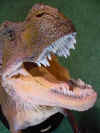
TOTALLY AWESOME
Tyrannosaurus Rex trophy head wall mount.
Leaves the kids with big round eyes...not to mention adults!
Extremely realistic.
We no longer carry the item, enjoy the photos!
|
| INFORMATIONAL ONLY
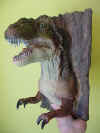
MINI T-REX DINOSAUR WALL MOUNT/KEY HOLDER
We no longer
carry the item, enjoy the photo! |
Click to go to: Page
2 Page 3 Page
4 Page 5 Page
6 Page 7 Page
8 Page 9 |